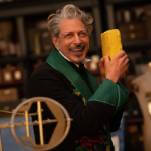This week’s entry: Oliver Cromwell’s head
What it’s about: You know you’ve made it when your head has its own Wikipedia page. Of course, it helps if your head’s been separated from your body. That’s what happened to Oliver Cromwell, though he died from kidney problems, not decapitation. Cromwell, Lord Protector of England who ruled the country after disbanding the monarchy, was given a state funeral in 1658, then dug up and beheaded two years later after the monarchy was restored.
Biggest controversy: In death, Cromwell became everything he hated in life. A Puritan who banned gambling, theater, and Christmas, he had a lavish funeral quite literally fit for a king (it was based directly on that of James I). He overthrew the monarchy, but was a ruler for life who passed down his title to his son. That son, Richard Cromwell, was ineffectual, and made the mistake of picking a fight with the army, who deposed him, and soon after put the royal family back on the throne with Charles II. Charles had his fathers’ killers, Cromwell among them, dug up and posthumously executed.
Strangest fact: Cromwell’s head was a tourist attraction for decades. After the Lord Protector’s corpse was decapitated, his head was put on a spike above Westminster Hall. It stayed there for the remainder of Charles’ reign, and well into that of his brother, James II. A storm knocked it down sometime around 1689 (though different sources can disagree by more than a decade in either direction), and a guard swiped it and hid it in his chimney while all of London searched for it.
Thing we were happiest to learn: The head eventually made it out of the chimney. No one’s exactly sure where or how, but it resurfaced in 1710 in a private museum in London, where it became a popular attraction. It faded in popularity until late in the century, when it fell into the hands of a failed actor, notorious drunkard, and rumored distant relative to Cromwell, named Samuel Russell. Russell treated the head considerably worse than the museum did, passing it around at parties, which caused “irreparable erosion of its features.”
A goldsmith named James Cox tried to buy the head from Russell but was rebuffed. Instead, he loaned the debt-ridden actor more and more money, until, knowing he couldn’t pay back the loans, graciously accepted the head as payment. He turned around and sold the head for more than twice what he had loaned Russell. The head was once again exhibited, but since Cox couldn’t confirm where the head had been before Russell owned it, it was discredited as a fake.
The head passed through various hands, and was dogged by rumors of inauthenticity until 1911, when another competing Cromwell head surfaced. The other head was declared fake, and the one Cox had sold was declared the genuine article. Finally, the head’s latest owner, Horace Wilkinson, asked Sidney Sussex College to give the head a proper burial, which it did in secret in 1960, only announcing the head’s final resting place in late 1962.
Thing we were unhappiest to learn: No one’s entirely sure what happened to Cromwell’s body. The likeliest story is the one biographer John Morrill tells, which is that his body was thrown into a pit at the site of his execution. Various other theories involve Cromwell’s supporters giving him a more dignified (second) burial. Alternate suggested locations for this include Naseby (the site of one of his military victories) or the deepest part of the Thames.
The wildest story came from Samuel Pepys in 1664, who claimed Cromwell had swapped bodies of various dead kings from one grave to another, with another story raising the possibility that it wasn’t Cromwell’s corpse that was decapitated, but that of Charles I (unlikely, given that Charles already lost his head the first time around).
Best link to elsewhere on Wikipedia: Cromwell (and former Wiki Wormhole subject Pope Formosus) was far from the only historical figures to be dug up just so they could kill him again. There are a fair number of posthumous executions throughout history, mostly in England, though most of Europe got into the game at some point. The most famous is likely that of Rasputin, who was poisoned twice, shot three times, and then drowned. He was dug up three months after being buried, and then burned, so his grave couldn’t be used as a rallying point for supporters of the recently deposed tsar.
Further down the Wormhole: One of many prominent figures who dismissed Cromwell’s head as a fake was Thomas Carlyle, a Scottish philosopher and satirist considered one of the most important social commentators of the Victorian era. (Among other things, he coined the phrase “the dismal science,” to refer to economics.) His fiction writing put him in the company of the Romantics, most famous of which is former Wormhole subject Alexandre Dumas. One of France’s bestselling authors of all time, his best-loved works are the d’Artagnan Romances, a series of serials whose most famous entries are its first—The Three Musketeers—and its last—The Man In The Iron Mask. While Dumas’ works are fiction, the latter was ripped from 17th-century headlines, as the Man In The Iron Mask was a real guy. We’ll try to peek behind the mask next week.








































